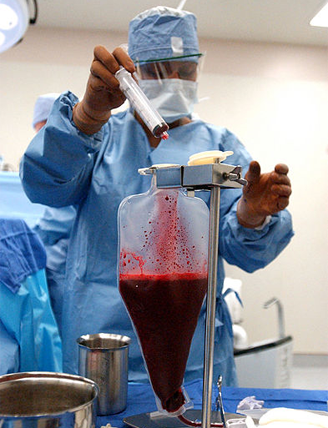Age Not a Barrier to Half-Matched Bone Marrow Transplants
Patients aged 70 years or older had similar survival outcomes compared to their younger counterparts when undergoing nonmyeloablative, related haploidentical bone marrow or peripheral blood stem cell transplants for the treatment of hematologic malignancies, according to the results of a study presented at the 2013 ASH meeting.
A surgical technician places recently transfused bone marrow into a sterile bag in preparation for transplant.

Patients aged 70 years or older had similar survival outcomes compared to their younger counterparts when undergoing nonmyeloablative, related haploidentical bone marrow or peripheral blood stem cell transplants for the treatment of hematologic malignancies, according to the results of a study presented at the 2013 American Society of Hematology (ASH) Annual Meeting and Exposition.
Based on these results, researchers led by Yvette L. Kasamon, MD, of the Johns Hopkins Kimmel Cancer Center, concluded that age should no longer be considered a barrier to gaining successful outcomes in older patients undergoing these procedures.
“Let it be known out there that with recent advances in how we do these haploidentical transplants, haploidentical transplants are a reasonable consideration for patients who don’t have matched donors and otherwise are in desperate need of a transplant,” Kasamon said. However, she did point out that outside of Johns Hopkins there are still relatively few centers performing haploidentical transplants.
Until now, little data have been available on the safety and efficacy of performing nonmyeloablative haploidentical bone marrow or peripheral blood stem cell transplants on patients aged 60 years or older. To explore outcomes in this patient population, Kasamon and colleagues conducted a retrospective analysis of 273 consecutive patients with poor-risk or advanced hematologic malignancies who underwent this procedure at Johns Hopkins.
All patients enrolled underwent graft-vs-host disease prophylaxis with high-dose post-transplant cyclophosphamide, mycophenolate mofetil, and tacrolimus. Of the 273 patients, 154 were aged 60 years or older and 27 patients were aged 70 to 75 years. Fifty-one percent of patients had a high-risk comorbidity index score and the majority of patients were at least of intermediate risk. None of the patients aged 70 years or older were considered low-risk.
Using patients aged 50 to 59 years as the reference, the researchers found no statistically significant association between advanced age and nonrelapse mortality or progression-free survival.
No significant difference was seen for progression-free or overall survival probabilities. The 2-year progression-free probabilities were 39% for patients in the 50s, 36% for patients in their 60s, and 39% for patients in their 70s. Similarly, the overall survival probability for patients in their 50s was 51%; 56% for 60s; and 44% for 70s.
Overall safety outcomes were encouraging, according to Kasamon. Eighty-nine percent of patients had neutrophil recovery by day 30 and 85% of patients had platelet recovery by day 60. There was a low-risk of nonrelapse mortality or transplant-related death with an 11% incidence at 6 months. Additionally, at 6 months there was only a 3% incidence of severe graft-vs-host disease.
“Since many elderly patients may lack a suitable matched donor, haplo option becomes even more attractive because children can be potential donors,” Kasamon said. “This platform with post-transplant cyclophosphamide appears to have toxicities and outcomes that are similar to what one might see in matched bone marrow transplant.”
Newsletter
Stay up to date on recent advances in the multidisciplinary approach to cancer.